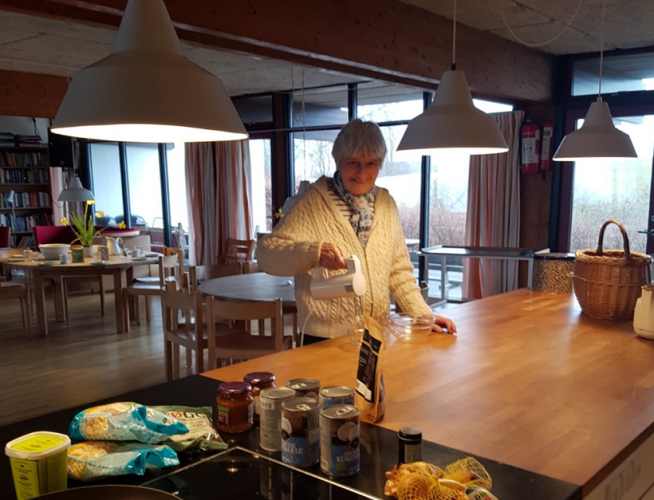Communal and intergenerational living in the Netherlands and Denmark
I applied for the Churchill Fellowship under the category of New Approaches to Social and Affordable Housing in 2017.
As an NHS commissioner and co-chair of the Housing LIN Steering Group for the East of England, I am interested in the needs and aspirations of older people, living in communities, in later life. My Fellowship took me to the Netherlands and Denmark to study intergenerational, communal and co-housing models and my Fellowship report can be found here: Supported Independent Living: Communal and intergenerational living in the Netherlands and Denmark.
With the current APPG on Social Integration (opens new window) looking at breaking down the barriers to intergration, and in particular on intergeneration housing, this study is particularly pertinent to the United Kingdom, as the challenge to support older people in good quality housing that promotes care, wellbeing and alleviates loneliness has been well documented by the government. The NHS’s recently published Long Term Plan also sets out how care models will be designed to meet communities’ needs, with local responses and infrastructure to support all of its residents. This has an implication for housing and accommodation to be part of that infrastructure.
The normative values of communities and intergenerational living are the main focus of the study and learning was gained from the Amsterdam City Government, Humanitas and De Hogeweyk in the Netherlands and from the intergenerational community, Sættedammen, in Denmark."Does Intergenerational Living Work?"
Social Policy in the City of Amsterdam
For older people’s housing, there are similar issues to the UK regarding loneliness, under-occupancy and supporting later life choices. However, there is also a strong message of self-responsibility and support to make those important choices, underpinned by legislation which enables care and support to fit around the person’s needs.
Humanitas, Sættedammen and De Hogeweyk
Humanitas is a residential and nursing home in the Netherlands that provides accommodation and care to 160 residents and there are also respite rooms. Six students live amongst the residents. Sættedammen, in Denmark, is a community of intergenerational residents living within a co-housing environment. There are 70 people in the community. De Hogeweyk, in the Netherlands, is a residential village which specialises in the care of 150 older people with dementia.
Critical Success Factors
The major part of my enquiry was to determine the critical success factors of supported, independent living within a communal or intergenerational setting. The critical success factors I identified in Humanitas, Sættedammen and De Hogeweyk are the following and are discussed in detail in the report:
- Shared ethos of relational care and empathy
- Daily rituals
- Deliberate interactions between older and younger people
- Organisation and distributed leadership
- Self-management of care
- Enabled environments

Above: Hygge Time at Sættedammen, Denmark
Conclusions
Does Intergenerational Living Work?
“Yes, this works. People are normal human beings and the combination of different people makes a community.”
Whilst the communal life could be all consuming, this was also deemed to be a positive, as there was lots on offer and much to give to the communal way of life. There were clear benefits for the sandwiched age groups at Sættedammen – for parents of young children, having extra grandparents to support childcare was invaluable. There was also support in De Hogeweyk for everyday tasks, like meal preparation and laundry and encouragement of people with dementia to undertake leisure activities.
“The impact of Humanitas is that it is creating the next generation of being a good neighbour. The take aways are about values. A ten minute chat is valued and an arrangement is made.”
Humanitas may be classified as an ongoing social experiment, but at the heart of the facility is care, support and respect of older people and adults of all ages. I was left with a sense that it’s the student residents who will gain invaluable and immeasurable benefits into their adulthood.
Recommendations
- Under-occupation of Homes by Older People - The UK housing market needs to cater for a heterogeneous older generation, who have care needs or future care needs and who may prefer some technological solutions to aid daily living.
- Combatting Loneliness - Combatting loneliness by making communities more accessible and by mixing the desired cohorts inter-generationally for new building developments would prevent creating “ghettos” or segregated communities.
- Preventing Health Deterioration Among Communities - Reducing overtly clinical models in care settings can help people to self-manage more and become less institutionalised. The UK should also support the development of intentional intergenerational communities in all of their many forms, as a response to the localised delivery of care.
- Designing Healthier Built Environments - A continuation of the Health New Towns initiative is recommended, with expansion into many more sites.
- Accessibility and the Market - The voluntary sector has a large and significant part to play with social connectedness and in encouraging older people to access their rights. The innovation of De Hogeweyk and Humanitas should be included as models of care which social care, housing and the NHS can learn from.
Gita Prasad works as an NHS Commissioner for NHS Norwich CCG and is the co-chair of the Housing LIN for the East of England. To access a range of other relevant resources on intergenerational housing, the Housing LIN curates a dedicated page on its website: Intergenerational Housing.

Comments
Add your comment